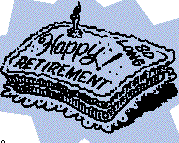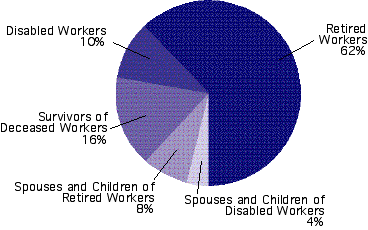Retirement is an invention of the modern age, a new stage of
life created by industrial society.
More than half of Americans lived and worked on farms until the 1870s.
Then a burst of industrial activity drew millions into the cities and
towns.
Both farmers and factory workers toiled until their strength gave out.
Then it was the family's obligation to care for the elderly who could
no longer work.
For those without spouses, siblings or children, the prospects were
grim. Counties and local communities opened workhouses, or poorhouses
for the destitute. Going "over the hill to the poorhouse" was the grim
fate of the elderly.

A handful of lucky people got old age pensions, including some veteran
employees of the railroads. But the idea of a universal system of
retirement security seemed like a radical dream.
The Great Depression smashed the American economy in 1929, wiping out
banks, shutting businesses, closing factories, and throwing millions
out of work. By 1933, a staggering 25% of American workers were
unemployed.
The federal government gave loans and grants to states to help with
local relief. But these measures fell short, and local officials were
overwhelmed with the tide of economic misery.
President Franklin D. Roosevelt appointed a special organization in
1934 to prepare a strategy for attacking the Depression. It was called
the Committee on Economic Security - four cabinet officers and
federal relief administrator Harry Hopkins - its attention quickly
turned to the idea of social insurance, programs that would protect
the entire population.
The idea was essentially imported from Europe, where several countries
had jobless insurance and old-age pensions. In this country, the idea
of insurance for workers was strictly limited to the workers'
compensation programs operated by states for employees injured on the
job.
The committee and the Roosevelt Administration had to maneuver among
competing political forces. The business community was largely opposed
to social insurance and the new taxes it would bring. Meanwhile,
citizens were clamoring for drastic action from the government.
A movement led by Dr. Francis Townsend called for a pension of $200 a
month for every citizen over the age of 60. They would get the money
if they stopped working and agreed to spend each month's allotment
within 30 days. Townsend, a doctor from Long Beach, Calif., soon had a
nationwide following of millions. The scheme was appealing because it
would remove millions of people from the crowded labor markets, and
provide an injection boost of cash to the economy.
At the same time, Sen. Huey Long, a Louisiana Democrat, was making the
White House nervous with his slogan, "Every Man a King," and his
populist program, "Share Our Wealth." He wanted to guarantee every
family, so they could buy a radio, a car and a house. Long wanted
federal laws to limit annual incomes to $1 million, inheritances to $5
million, and private fortunes to $50 million.
The Committee on Economic Security finally settled on a social
insurance plan, with contributions by workers and businesses to fund
payments. The goal was to protect workers against the loss of income
because they had retired.
The Social Security legislation was passed by Congress in 1935 with
the ambitious goal of providing "for the general welfare by
establishing a system of federal old age benefits..."
The tax was 1% each for the worker and the employer on earnings up to
$3,000 a year. (This maximum tax, $30 a year, remained unchanged until
1950.)
The age for drawing benefits was set at 65, in the kind of
split-the-difference compromise that characterizes much of American
politics. "We thought 60 as suggested by the Townsend plan was too
low, and the country couldn't afford it," recalled Robert J. Myers,
who worked for the committee as a young graduate from the University
of Iowa. "And 70, which was the retirement age for some railroad
plans, was too old. Not many people would live that long. So we picked
65 as the age."
The retirement benefit was available for workers only.
It was the beginning of a revolution in American government and
society. For the first time, the American people had decided that the
federal government - states, or cities, or local charities - a
formal responsibility for the economic well-being of its citizens.
Today, billions of dollars flow from Washington every day in payments
to assure the economic and physical health of Americans, and no one
thinks twice about this activity. But in 1935, it was a dramatic and
historic break with history.
Taxes were first collected in 1937, with several years scheduled for
the trust fund to build its balances. Those who became 65 in 1937-40
received lump sum payments. The first person who collected money was
Ernest Ackerman, who turned 65 one day after Social Security began in
1937. A nickel was withheld from his pay, and he collected 17 cents in
benefits. The average lump-sum in 1937-39 was $50.06.
Changes were made in 1939 so that regular monthly retirement payments
began in 1940, and the categories of beneficiaries were expanded from
retired persons to include their dependents. And payments were also
available to survivors of workers who died before or after reaching
retirement age.
Ida Mae Fuller, of Ludlow, Vermont, received the first monthly check,
in January 1940, for $22.54. She died in January, 1975, aged 100,
after collecting more than $20,000 in benefits.
The program grew steadily. In 1956, disability benefits were added to
protect workers and their families when illness cut short their work
lives.
In 1965, Medicare was added as another pillar of social insurance to
help pay the doctor and hospital bills for those over 65 (and in 1972
to the long-term disabled of all ages).
To fight the ravages of inflation, the law was changed in 1972 to
provide an automatic increase, a cost-of-living adjustment each year
in the Social Security check.
Today, more than 95% of the work force, some 145 million people, pay
Social Security taxes. The deduction from the paycheck is 6.2% each by
the worker and the employer, on wages up to $68,400. (The Medicare
payroll tax is 1.45% each for worker and employer on all wages.)
Self-employed persons pay the full tax, 12.4%, for the the retirement
and disability programs, and 2.9% for Medicare.









